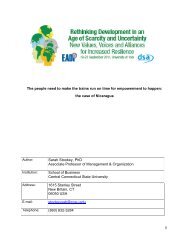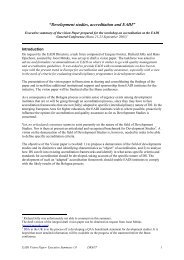Revenue Administration in Sub-Saharan Africa - International Tax ...
Revenue Administration in Sub-Saharan Africa - International Tax ...
Revenue Administration in Sub-Saharan Africa - International Tax ...
You also want an ePaper? Increase the reach of your titles
YUMPU automatically turns print PDFs into web optimized ePapers that Google loves.
A. <strong>Tax</strong>payer registration and design of taxpayer identifiersIntroduction<strong>Tax</strong>payer registration is the first po<strong>in</strong>t of contact and the <strong>in</strong>itial level of the taxcompliance process. Modern revenue adm<strong>in</strong>istrations therefore strive to develop andma<strong>in</strong>ta<strong>in</strong> quality and up-to-date taxpayers’ registers. <strong>Revenue</strong> bodies were asked toprovide detailed <strong>in</strong>formation on their taxpayer registration systems.Survey results (Table 17)• Most of the revenue bodies <strong>in</strong>dicated that they assign taxpayers anidentification number ostensibly across all tax types, <strong>in</strong>clud<strong>in</strong>g customs.• The taxpayer identification number is comprised of between 8 (Malawi andSierra Leone) to 13 characters (Zambia).• The characters are either numeric (10 revenue bodies) or a comb<strong>in</strong>ation of bothnumeric and alphabetic (5 revenue bodies).• Seven revenue bodies reported they have additional identifiers for CIT and VAT.Key observationsTo effectively manage taxpayer compliance across all tax types, modern revenueadm<strong>in</strong>istrations typically implement taxpayer identification systems that comb<strong>in</strong>eboth simplicity and uniqueness <strong>in</strong> design. Progress, therefore, has been made <strong>in</strong> thisarea, <strong>in</strong>clud<strong>in</strong>g <strong>in</strong> a few countries, implementation of one-stop-shop bus<strong>in</strong>essregistration offices 85 and automated registration and f<strong>in</strong>gerpr<strong>in</strong>t identificationsystems. 86 Seven revenue bodies reported they have additional identifiers for CIT, PITand VAT. Implementation of a common unique taxpayer identifier across all tax-typesis generally regarded as good practice. Effective cross-match<strong>in</strong>g of data us<strong>in</strong>g availablesystems and, where possible, <strong>in</strong>vest<strong>in</strong>g <strong>in</strong> additional data warehouse and data-m<strong>in</strong><strong>in</strong>gsolutions, skills and capacities would also greatly contribute to strengthen<strong>in</strong>g thecompliance management process.85 Mauritius, Sierra Leone and South <strong>Africa</strong> <strong>in</strong>dicated they have set up one-stop-shop registration offices.86 However, IMF experience shows that the quality and <strong>in</strong>tegrity of the taxpayer registration roll is questionable <strong>in</strong> mostcountries. The use of the common identify to manage taxpayer compliance has also rema<strong>in</strong>ed grossly undeveloped andunder-utilized. For example, it has been demonstrated <strong>in</strong> some countries that a number of large importers are notregistered for either <strong>in</strong>come tax or VAT.60





